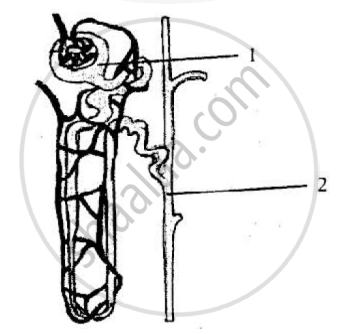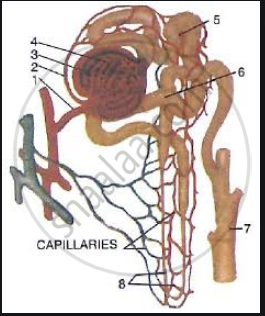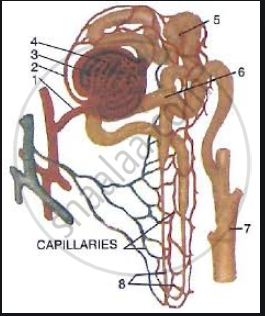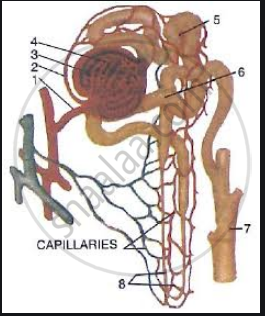Advertisements
Advertisements
प्रश्न
How is the amount of urine produced regulated?
उत्तर १
The amount of urine produced depends on the amount of excess water and dissolved wastes present in the body. Other factors, such as an organism's habitat and hormones such as Anti-diuretic hormone (ADH), also regulate the amount of urine produced.
उत्तर २
- The amount of urine produced is controlled by a hormone released from the posterior lobe of the pituitary gland, called antidiuretic hormone (ADH) or vasopressin. This hormone's role is to promote the reabsorption of water from the nephric filtrate.
- When there is sufficient water in the blood, less ADH is secreted, resulting in less water being reabsorbed from the nephric filtrate and, therefore, more urine is produced. Conversely, when there is less water in the blood, more ADH is released, leading to increased water reabsorption by the blood capillaries surrounding the nephron, which reduces the amount of urine produced.
APPEARS IN
संबंधित प्रश्न
Explain the term haemodialysis.
The kidneys in human beings are a part of the system for ______.
The diagram given below shows the male urinogenital system of a human being. Study the diagram and answer the questions that follow:

(i) Label the parts numbered 1 to 8.
(ii) Name the corresponding structure of part (4) in female reproductive system.
(iii) What is the role of part 7?
Explain Selective reabsorption
Draw the well-labelled diagram of the human excretory system
The diagram given below is that of a structure present in a human kidney.
Study the same and answer the questions that follow:

1) Name the structure represented in the diagram
2) What is the liquid entering part ‘1’ called?
Name two substances present in this liquid that are reabsorbed in the tubule.
3) What is the fluid that comes to part ‘2’ called?
Name the main nitrogenous waste in it.
4) Mention the three main steps involved in the formation of the fluid mentioned in (iii) above
5) Name the substance which may be present in the fluid in part ‘2’ if a person suffers from Diabetes mellitus.
Where is the dirty blood in our body filtered?
Name a waste gas released by the plants only during the daytime.
What is the role of glomerulus in the kidney?
A dialysis machine contains long tubes coiled in a tank containing dialysing solution
Name the main waste which passes into the dialysing solution.
Where is urine carried through ureters?
What is meant by dialysis? What type of patients are put on dialysis?
Explain the principle of dialysis with the help of a labelled diagram.
The procedure of cleaning the blood of a person by using a kidney machine is known as:
(a) ketolysis
(b) hydrolysis
(c) dialysis
(d) photolysis
The organs A of a person have been damaged completely due to which too much of a poisonous waste material B has started accumulating in his blood, making it dirty. In order to save this person's life, the blood from an artery in the person's arm is made to flow into long tubes made of substance E which are kept in coiled form in a tank containing solution F. This solution contains three materials G, H and I in similar proportions to those in normal blood. As the person's blood passes through long tubes of substance E, most of the wastes present in it go into solution. The clean blood is then put back into a vein in the arm of the person for circulation.
(a) What are organs A?
(b) Name the waste substance B.
(c) What are (i) E, and (ii) F?
(d) Name G, H and I.
(e) What is the process described above known as?
Name the following:
The vein in which urea concentration is maximum
Define the following term:
Osmoregulation
What is dialysis? Under what condition is it carried out?
Choose the correct answer:
A condition of failure of kidney to form urea is called ____________
Choose the odd one out in the following series:
Proximal convoluted duct, loop of Henle, vein.
Choose the odd one out in the following serie:
Column of Bertini, minora calyces, brain.
The following diagram represents a mammalian kidney tubule (nephron) and its blood supply.

Parts indicated by the guidelines 1to 8 are as follows:
1. Afferent arteriole from renal artery
2. Efferent arteriole
3. Bowman's capsule
4. Glomerulus
5. Proximal convoluted tubule with blood capillaries
6. Distal convoluted tubule with blood capillaries
7. Collecting tubule
8. U-shaped loop of Henle
Study the diagram and answer the question that follow:
Which structure contains the lowest concentration of urea?
The following diagram represents a mammalian kidney tubule (nephron) and its blood supply.

Parts indicated by the guidelines 1to 8 are as follows:
1. Afferent arteriole from renal artery
2. Efferent arteriole
3. Bowman's capsule
4. Glomerulus
5. Proximal convoluted tubule with blood capillaries
6. Distal convoluted tubule with blood capillaries
7. Collecting tubule
8. U-shaped loop of Henle
Study the diagram and answer the question that follow:
Which structure contains the highest concentration of urea?
The following diagram represents a mammalian kidney tubule (nephron) and its blood supply.

Parts indicated by the guidelines 1to 8 are as follows:
1. Afferent arteriole from renal artery
2. Efferent arteriole
3. Bowman's capsule
4. Glomerulus
5. Proximal convoluted tubule with blood capillaries
6. Distal convoluted tubule with blood capillaries
7. Collecting tubule
8. U-shaped loop of Henle
Study the diagram and answer the question that follow:
Which structure (normally) contains the lowest concentration of glucose?
Name the Following
The structural and functional units of kidney
Name the Following
The term used for Bowman’s capsule and glomerulus together.
Complete the following sentence with appropriate word:
The knot of blood vessel inside the Bowman’s capsule is ______.
Write the functional activity of the following structure:
Glomerulus
Choose the Odd One Out:
Choose the correct option.
Which one of the following organisms excrete waste through nephridia?
The process of diffusion of solvent particles from the region of less solute concentration to a region of high solute concentration through a semi-permeable membrane is known as ____________.
In a person the tubule part of the nephron is not functioning at all. What will its effect be on urine formation?
“All plants give out oxygen during the day and carbon dioxide during the night”. Do you agree with this statement? Give a reason.
If a plant is releasing carbon dioxide and taking in oxygen during the day, does it mean that there is no photosynthesis occurring? Justify your answer.
What would happen if green plants disappeared from earth?
Certain organisms that are aquatic in habitat, tolerate only a narrow range of salinity. What term is given to such animals?
Give two examples of the following:
Nitrogenous waste
Which of the following is not an example of secretion?
Name the following;
Three nitrogenous wastes of our body.
